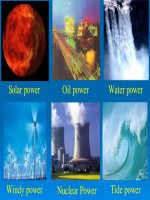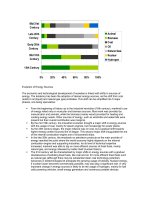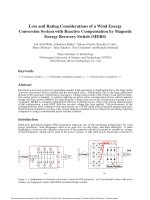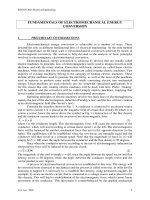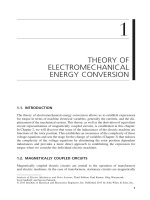Energy conversion materials
Bạn đang xem bản rút gọn của tài liệu. Xem và tải ngay bản đầy đủ của tài liệu tại đây (1.07 MB, 49 trang )
Energy Conversion Materials
The solar spectrum
o About 46% of the
spectral energy
is distributed in
the visible region
o About 49% in
near IR
o About 3% in UV
region and rest in
far IR region
Solar energy conversion devices
Methods of tapping solar energy
A. Photosynthesis
Plants
(Visible light )
η = 2-4%
B. Water heaters
Flat plate, tube
(IR radiation)
C. Photovoltaic cells
D. Chemical routes
p/n Si, a-Si, GaAs
(Visible light)
η = 12-26%
D.2 PEC cells
D.1 Biomimetism
Mimicking
Photosynthesis
via chemicals
b. Photoelectrosynthesis
a.
LJSC
(PES) cells
(i) Photoassisted
(i) Sc/Elect/M
η= 13-14%
(ii) Photogalvanic cells
M/Elect/M
η= 0.01%
electrolysis cells
η= 13.3%
(ii) Photoassisted
electrosynthesis
cells
eg.
CO2
N2
CH3OH
NH3
Drawback Of The Present Devices
1. These devices are quantum converters, in which a photon is absorbed resulting in an
electron-hole pair or breaking of the chemical bond
2. These can use only the relatively high energy photons and considerable portion of the IR
radiation cannot be used.
3. The photovoltaic
technology has very high efficiencies of the order of 26% (on a
laboratory scale) but it is not completely realised.
Photovoltaics &
Photoelectrochemical cells (PEC)
Terminology
o
In semiconductor physics, the depletion region, also called depletion layer, depletion zone, junction
region or the space charge region, is an insulating region within a conductive, doped
semiconductor material where the mobile charge carriers have diffused away, or have been forced
away by an electric field.
o
The only elements left in the depletion region are ionized donor or acceptor impurities.
o
The Fermi level is an energy pertaining to electrons in a semiconductor.
Devices of solar energy conversion
1.
2.
3.
4.
5.
Photovoltaic cells
Photoelectrochemical cells
Photogalvanic cells
Solar thermal (eg. water heater)
Dye sensitized solar cells
Photovoltaic cells
A solar cell is a device that converts the energy of sunlight directly into electricity by the photovoltaic
effect.
The photovoltaic effect involves creation of a voltage (or a corresponding electric current) in a material
upon exposure to electro-magnetic radiation.
Though the photovoltaic effect is directly related to the photoelectric effect, the two processes are
different
In the photoelectric effect electrons are ejected from a material's surface upon exposure to radiation of
sufficient energy.
The semiconductor / electrolyte interface
Relation to Fermi level
A. flat band potential
semiconductor
B. accumulation layer
electrolyte
semiconductor
+ - + - + - +
+ - + Ec
Ef
+ -
E
conduction band
+ -
- +
-
electrolyte
+
+
+
conduction band
Ec
Ef
Eredox
Eredox
Ev
Ev
valence band
valence band
-
conduction band electrons
+
positive charge carriers
-
electrolyte anions
D. inversion layer
C. depletion layer
semiconductor
+ - +
- + - +
+ - +
conduction band
Ec
Ef
semiconductor
electrolyte
+
+ + -
-
+
+
+
conduction band
E
electrolyte
E
Ec
Ef
Eredox
Eredox
Ev
valence band
E
valence band
Photoelectrochemical cells
Photoelectrochemical (PEC) cell is a device in which a photoactive semiconductor material is
in contact with an electrolyte .
Irradiation of the SC/electrolyte junction with light of energy > Eg,
the band gap of the
semiconductor, produces electron - hole pairs.
The electron-hole pairs are spatially separated (due to the junction potential) to drive
oxidation and reduction reactions in the system.
Photoelectrochemical effect at
semiconductor - redox electrolyte interface.
a)
On contact the Fermi level of the n-type semiconductor equilibrates with that of the metal and with the redox couple of the
electrolyte.
b) After charge (electron) transfer, a band bending is established as in the case of the previous solid-state junctions, with establishment of the depletion zone.
c) Under light, photoelectrons enter the conduction band; the band bending is reduced and a photovoltage is generated between the semiconductor Fermi level and the redox potential of the electrolyte - equivalent to the potential of the metal counter-electrode.
d)
Minority carriers - holes - are then available for an oxidation reaction with the electrolyte at the Semiconductor photoanode.
A reduction reaction takes place at the cathodic counter electrode.
Regenerative photoelectrochemical cells
Classification of Photoelectrochemical cells
PEC cells are Classified into two types according to their application.
1. Liquid Junction Solar Cell (LJSC) –
This cell is used to convert solar energy into electrical energy
2. Photoelectrosynthesis (PES) cells –
In this class of cells, solar energy is converted into chemical energy in the form of fuels.
Major advantages of PEC cells over photovoltaic cells
Easy junction formation (mere dipping of the SC
electrode in the electrolyte).
In-situ water electrolysis is possible.
Efficiencies of polycrystalline bulk and thin film
electrodes are comparable to those of single
crystal electrodes.
Novel reaction products are possible and catalytic
effects (Photocatalysis) can be induced on the SC
surfaces.
Particulate systems can be used.
Mechanism of Liquid Junction Solar Cells
The simplest LJSC consists of two electrodes (one of them a SC and the other a metal) dipped in an
electrolyte containing a redox couple.
Both the electrodes must be inert, i.e., the electrode material itself should not take part in the electrochemical reactions.
One of the important requirements for the operation of an LJSC is the presence of depletion layer at the
surface of the SC electrode.
For this, the initial Fermi level of the SC should be above (in the case of n-type semiconductors) the
Eredox.
Working of LJSC
The non-equilibrium electrons in the valence band are produced by illumination of light with energy
hν ≥ Eg.
The minority carriers (h+ in the n-type SC’s) are transferred to the surface where they are used up for
oxidation and the electrons are transferred to the surface where they are used up for reduction
The electrons are transferred to the bulk, then via the external circuit to the counter electrode,
where they are used up for the reverse reaction (reduction).
Liquid Junction Solar Cell (LJSC)
Cell : n-CdSe / Na2S + S + NaOH / Pt
At the anode:
S
2-
+
2+ 2h ---> S2
At the cathode:
22S2 + 2e --- > + S
Net reaction : Nil
Energetics of LJSC
Energetics of LJSC
Energetics of LJSC
Energy band representation of the
operation of PAE cell
(a)
in dark, after
equilibration
(b) under illumination
without applied bias
(c) under illumination
with applied bias to effect electrolysis
Photo-assisted electrolysis (PAE) cells
Cell : n-SrTiO3 / NaOH / Pt
At the anode :
+
2OH + 2h
½ O2 + H2O
At the cathode:
2H2O + 2e
-
H2 + 2OH-
Net reaction :
2H2O
2H2 + ½ O2
Conditions for Efficient Solar Energy Conversion – Electrodes
The requirements for the electrode materials are:
(1)
Band gap should be optimum (see section on
efficiency considerations).
(2) The doping level should be optimum so that there will be a good spatial separation of the photogenerated carriers and hence, high quantum efficiency.
Conditions for Efficient Solar Energy Conversion – Redox couple
The following are the requirements for the redox couple:
(i)
The electrolyte should have a value of Eredox
(ii)
Eredox should be in such a position that the
electrode decomposition reactions are not kinetically favoured
(iii)
The reactions at the two electrodes should be perfectly reversible
(iv)
Solution should have adequate transparency
(v)
There should be low ohmic resistance (in order to minimise the internal resistance of the cell).
Why Silicon
Silicon is a very common element abundant
in nature
(it is the main element in sand and quartz)
Silicon is considered as the most suitable
material for solar energy conversion
because of
1. its abundance
2. Optimum band gap of 1.23 eV at 300K
3. Cost effectiveness
Production of Silicon
1. Metallurgical Grade Silicon:
SiO2 +2C
Si +2CO
Sand (SiO2) is heated with carbon in an electric furnace to reduce it.
The silicon thus obtained is 99% pure and is called metallurgical grade silicon.
This is purified further to reduce levels of impurities to make it suitable for use in devices.


